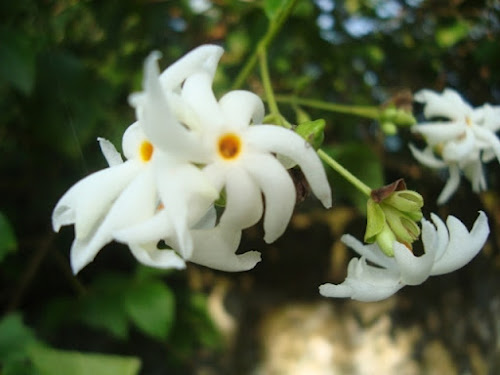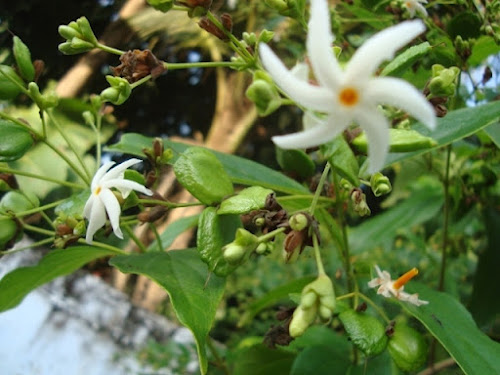Etymology and Names of Paarijat or coral jasmin
Har shingar is also
called Coral Jasmine, Tree of Sorrow, Queen of the night and Night-flowering
Jasmine. It is called Har shingar, Shefali,
Paarijat in Hindi, Shefali and Shiuli
in Bengali, Singarei in Manipuri , Hkhewali
in Assamese , Pagadamalle in Telugu , Pavizhamalli or pavala malli in Tamil, Goli in
Kannada , Paarijatam in Malayalam. In Sanskrit it is called Parijata, Prajakta,
Vijaya, Subaha, Nalakumkumaka, , Suklangi, Chakrabrinta, Kharapatraka, Rajanihasa, Nisahasa, Praharshini,
Pravalanalika, Vathari, Bhoothakeshi, Seetamanjari, Ragapushpi
Nishipushpika. In Oriya we call it Ganga shiuli, Shingda hara, Shefali or Jhara Shefali.
 |
| Night-flowering Jasmine |
Its botanical name is Nyctanthes arbortristis and it belongs to the Oleaceae i.e. Jasmine family. Nyctanthes arbortristis literally means, night-blooming sad tree. The tree is also called the "tree of sorrow", because the flowers drop from their branches in the morning.
It’s generally native to southern
Asia and it is a common flower in countries of India, Pakistan, Nepal, Bangladesh
and Thailand.
 |
| Shefali, Paarijat, |
It grows as a shrub
or a small tree up to 10 m. tall, with a gray or greenish, rough and flaky bark. Leaves are simple, opposite,
oval with pointed tips, 6–12 cm long and 2–6.5 cm broad, toothed at the edges
and rough like sandpaper on the upper surface. The flowers are very sweet
scented with waxy white, star-like petals and an orange-red tube in center
which bloom in clusters. The flowers open at dusk and drop at dawn. The fruit
is flat brown heart-shaped, 2 cm diameter and two seeded.
The flowers are
used as yellow dye
for clothing and the oil extracted from the flower is made perfume.
 |
| har singar tree. |
Every part of the
tree is very useful and contains great ayurvedic/medicinal property. It is expectorant, bitter, tonic, febrifuge and is used to treat anxiety,
restlessness, headache, gastritis, hepatitis, diarrhea, vertigo and
dysmenorrhoea. It is used in the treatment of fungal skin infection, dry cough,
and bronchitis and as an antidote for snakebites. The flowers are bitter, astringent, ophthalmic, stomachic, carminative, diuretic,
anti-bilious, antioxidant, anti-inflammatory, sedative, antifilarial and it cures arthritis. The decoction of
flowers is used in treating gout. The leaves are used
as a laxative. Paste of the leaves is used in skin related troubles,
especially ringworm. The leaves are boiled in mustard oil and it is used
externally for treating ringworm. The leaf juice is mixed with common salt or misri to treat intestinal worms. For gynecological problems 3 fresh leaves
blended with 5 black peppers is taken. If 3-4 leaves are crushed to a
fine paste and are boiled with water (the decoction or quatha called in Ayurveda); the water extract taken twice daily
cures sciatica, swelling and pain. Juice of leaves taken with honey cures dry cough. Take a handful of leaves
with 2-3 leaves of tulsi and boil in
water and take two tbsp thrice daily to cure any kind of fever. The seeds are antibacterial and antifungal. The seed paste is externally applied on the piles. The
decoction of its seeds is used as a hair tonic. Washing hair daily with this
tonic helps to get rid of dandruff and lice. The bark is anti-microbial. The stem is
antipyretic and antioxidant. 200 ml. decoction made from the leaves,
barks, flower (when boiled with water and reduces to ¼ of initial quantity)
cures arthritis.
 |
| Nyctanthes arbortristis |
I’ll relate one of my personal experiences of the efficacy of the wonderful
property of this plant. Around ten years ago during my stay at Cuttack once I
suffered from viral fever. The fever subsided after one week. But intermittent
slow temperature and feverish feeling continued. I kept taking medicine. After
one month I grew tired of them. I asked our housemaid to collect me some leaves
of Har shingar tree. She gave it to
me. I washed them and boiled them with 1 glass water. When the water was
reduced to 1 cup I took it out and let it cool down. Then I crushed the boiled
leaves a bit and extracted the water. I took it simply even without honey or Tulsi thrice daily for two or three
days. My fever, temperature everything was completely cured without any further
medication. I have tried and have got the good result. It has no side effect at
all. It’s the miracle medicine for all kinds of fever no doubt.
N.B.👉All the above is solely for informational purpose and NOT INTENDED TO PROVIDE ANY KIND OF MEDICAL ADVICE. A REGD. AYURVEDIC/MEDICAL PRACTITIONER SHOULD ALWAYS BE CONSULTED FOR IT.